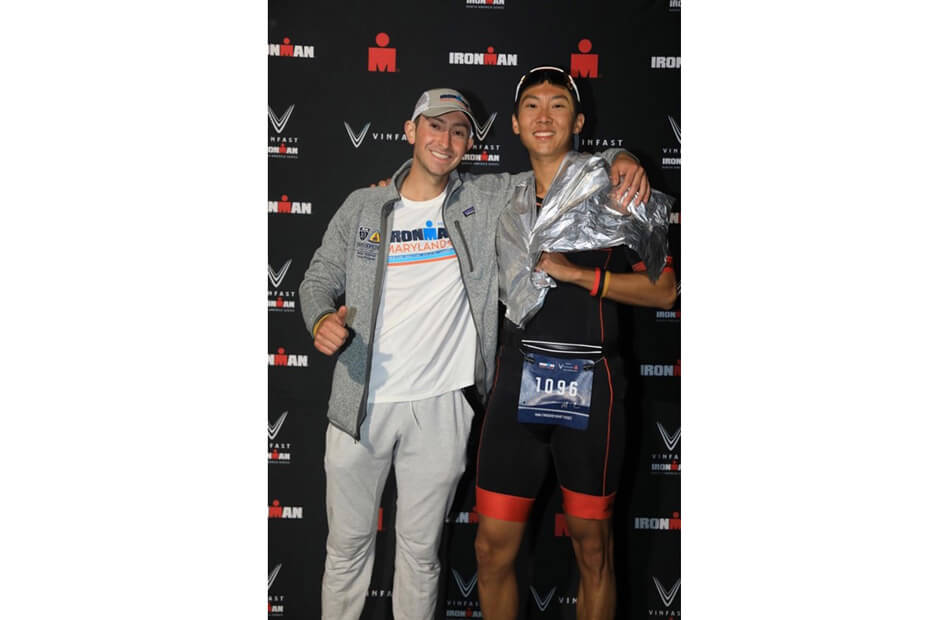Photo courtesy of the author. Second-year medical students Luke Tomasovic, left, and Thomas Su at the finish line of the 2023 IRONMAN Maryland.
At the start of medical school, I was advised to take it all in stride because “it’s a marathon, not a sprint.” I agree, but with one caveat. Medical school is an Ironman, not a sprint. Let me explain.
An Ironman triathlon is among the most physically demanding single-day endurance races in the world, consisting of a 2.4-mile swim, followed by a 112-mile bike ride and concluding with a full marathon run of 26.2 miles. Since the iconic event was first conceived on the Hawaiian island of Oahu in 1977, images of depleted athletes running (or in some cases, crawling) across the finish line have captivated the imaginations of aspiring participants.
While finishing an Ironman had been on my bucket list for as long as I could remember, I convinced myself that it would have to wait. Maybe I would reconsider once I was done with medical school and had “more time” (laughable, I know). But several months into my first semester, I was growing restless and feeling uninspired by my bottomless pit of Anki cards. So, I impulsively registered for IRONMAN Maryland and decided I would figure out the rest later.
Long story short: I figured out the rest later. Here’s what I learned along the way:
Pace yourself.
As I learned almost immediately, the “harder” you swim, the slower you will go. Likewise, the “harder” you study, the faster you burn out. If you’re an overeager (check) and impatient (check) medical student, you want to learn as much as possible, as quickly as possible. Unfortunately, that’s not how it works. In the same way that one can’t learn all of human anatomy in one night, there are no shortcuts to Ironman training. Slow is smooth, and smooth is fast.
Swallow your pride.
Most Ironman hopefuls begin their training with a healthy level of confidence in their athletic abilities. But, any swollen ego is quickly deflated upon realizing its mediocrity at three different sports. Similarly, most students start the first day of medical school feeling pretty smart. Otherwise, they wouldn’t be there, right? Then, the Dunning-Kruger effect inevitably sets in, and they accept that they don’t even know what they don’t know. In each case, the next decision is important. Do they admit their ignorance and ask for help? Or, do they double down for fear of looking stupid?
You’re not supposed to be very good in the beginning — that’s why it’s called training.
Show up, especially when you don’t want to.
Fueled by the afterglow of my Ironman registration and an excess of motivational YouTube compilations, the first few weeks of my training felt surprisingly effortless. But eventually, I dreaded even the idea of hopping on a stationary bike or jumping into a cold pool after long days of studying. For me, medical school was no different. Once the honeymoon period of novelty ended, I often found myself complaining about time-consuming lectures and mandatory attendance. If medical students and triathletes could agree on one thing, it’s that we don’t rise to the level of our expectations. We fall to the level of our habits. It’s impossible to feel motivated every day, but those are the days when it’s most important to show up, for both yourself and others.
When the why is powerful, the how is easy.
As my training schedule began to crowd out other facets of my life, I began questioning why I was training to begin with. In endurance sports, and in medicine, self-serving motives will only take one so far. When I spoke with other participants before and after the event, I was struck by their wide range of motivations. For some, completing an Ironman was a tribute to a deceased friend or family member. Others raced to show appreciation for their bodies after overcoming a debilitating illness. Regardless of the stories that led them to the starting line, everyone was running an individual race. Whether you’re on mile 15 of a marathon or stuck in the library late at night, remember your “why” and keep moving forward.
What you can be, you must be.
Over the past year, I’ve been continually reminded of an excerpt from What I Talk About When I Talk About Running, a memoir by the renowned fiction author Haruki Murakami. In it, Murakami states that “a person doesn’t become a runner because someone recommends it. People basically become runners because they’re meant to.” Whether one is meant to become an Ironman or a physician, each represents the pinnacle of Maslow’s famous pyramid: self-actualization. Whatever your personal ideal looks like, it will (and should) seem impossible at first. But relax — that’s just a sign that you’re on the right track.
At this point, you’ve probably realized that I’ve talked very little about my experiences during the race itself. Did I enjoy it? Yes, when it was over. Was it painful? Of course. In the final stages of the run, though, the following phrase came to me: “I hurt so others don’t.” Where it originated, frankly, I’m not sure. Maybe it came from the Muse, or maybe from the depths of my glucose-deprived brain. Although oozing with idealism (and a dash of masochism), I think the underlying message is what draws many toward medicine. Personal sacrifices in service of others are inevitable parts of the journey, but often the most rewarding. And wherever that journey may ultimately lead, it can only be completed step by step.
Special thanks to my classmate, Thomas Su, for being a great training partner and an even better friend along the way.
Related Content
- Spring into Fitness: The Annual JHUSOM Virtual Fitness Challenge
- A Gold Medal for Wellness
- The Progressing Path
Want to read more from the Johns Hopkins School of Medicine? Subscribe to the Biomedical Odyssey blog and receive new posts directly in your inbox.
